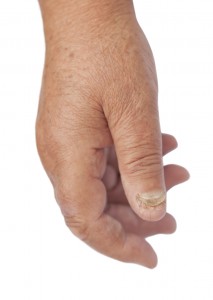How Do You Know If You Have A Nail Fungal Infection?
 Nail fungus, also known as onychomycosis, is a common irritant that starts off as a white or yellow dot on your nail. If the infection has the chance to grow nails will begin to discolor, thicken, and possibly take on a crumbly appearance. Nail fungal infections can persist on one nail or multiple nails, but in most cases the infection does not impact all nails.
Nail fungus, also known as onychomycosis, is a common irritant that starts off as a white or yellow dot on your nail. If the infection has the chance to grow nails will begin to discolor, thicken, and possibly take on a crumbly appearance. Nail fungal infections can persist on one nail or multiple nails, but in most cases the infection does not impact all nails.
A nail fungal infection may look really bad but all that you need is proper medical attention to revive the beautiful nails you had before the fungus moved in. Here we explain all about fungal infections, including how you may have developed the infection, common symptoms, and how to treat the fungus before it has a chance to spread further.
What Is A Fungal Infection?
Fungus is a type of plant, including mushrooms, mold, and mildew. Fungi can live in the air, soil, plants, water, and some even live in your body. Fungus thrives in warm, damp environments, which is one reason why toenail fungus is more common than fingernail fungus. Toes also tend to receive less blood flow than fingers, decreasing your body’s immune system response to this area. A nail fungal infection usually begins as an infection of the skin before spreading to the nails.
What Causes A Nail Fungal Infection?
A nail fungal infection can be spurred by a couple of things. Fungi can make its way inside a cut so small your eyes can’t even see it. Your daily activities can heighten your risk factor, for instance if you frequent public swimming pools and showers. These types of locations provide fungi with the perfect warm, moist environment they crave.
You are at a greater risk for developing a fungal infection if you:
- Go to nail salons for manicures and pedicures where the same tools are used on multiple people without proper sanitation.
- Are prone to skin and nail injuries
- Suffer from deformed nail disease
- Nails and surrounding skin are exposed to moist, warm conditions for prolonged periods of time
- Have a weakened immune system for any reason
- Regularly wear closed-toe footwear
What Are The Signs And Symptoms Of Nail Fungus?
You may have a nail fungal infection if you notice one or more of the following symptoms plaguing your nail(s):
- Appear thickened
- Are brittle or crumbling
- Appear distorted in shape and color
- Have lost all shine and appear very dull
- Show a dark color on the underside
In more severe cases onycholysis may occur, which is the physical separation of the infected nail from the actual nail bed.
Diagnosing Fungus Infections
Visiting a doctor is the best way to diagnose and treat a nail fungal infection. A doctor will conduct a physical examination of your nails. He or she may also take a sample of nail debris to send over to a lab for testing in order to identify the type of fungus responsible for the infection.
There are other conditions that appear to be fungal infections but are actually caused by something else. Psoriasis is one possibility that looks like a fungal infection, as well as microorganisms including yeast and bacteria. In order to receive effective treatment it’s important to know what is causing the infection in the first place.
Nail Fungal Treatment Options
There are multiple treatment options available for nail fungus, some more extreme than others. Some common treatments include:
- Oral antifungal drugs prescribed by your doctor will help your new nail grow in healthy and free of infection.
- Your doctor may prescribe medicated nail polish (ciclopirox). You will apply this polish to infected nails and nearby skin each day for one week, at which time you remove the build up of polish and begin again. Some people require this type of treatment for an entire year.
- Medicated nail cream is another option prescribed by doctors. Thinning nails prior to using this cream helps the medication penetrate through the nail to the underlying source of the infection.
- Nail removal is only necessary if the infection has become very severe and painful. In almost all cases a new nail will grow back, but it can take as much as a year to fully do so.
- Laser fungal nail treatment is a rather new method that is still undergoing some research. One study found most people do benefit from the treatment, although it can be expensive and is only offered at some clinics.
Complications Related To Nail Fungus
Nail fungal infections will continue to worsen without treatment, and can become very painful as well as lead to permanent damage of your nails. If you have a weakened immune system or diabetes, the infection can spread from your nails to other parts of your body.
When To Visit Urgent Medical Center For Nail Fungus
Signs you should go to Urgent Medical Center as soon as possible for a nail infection:
- If fungal nail infections are persistent and don’t go away
- Your fingers or toes are red, draining pus, and/or painful
If you are suffering from what appears to be a nail fungus, visit your local Urgent Medical Center today for fast, effective treatment.

